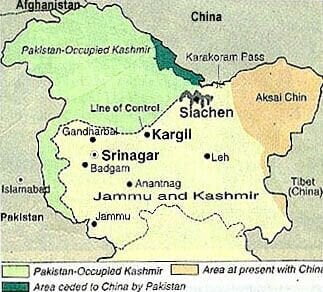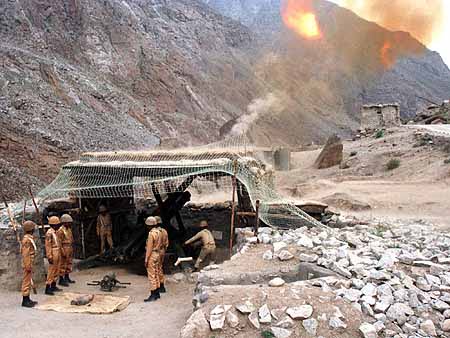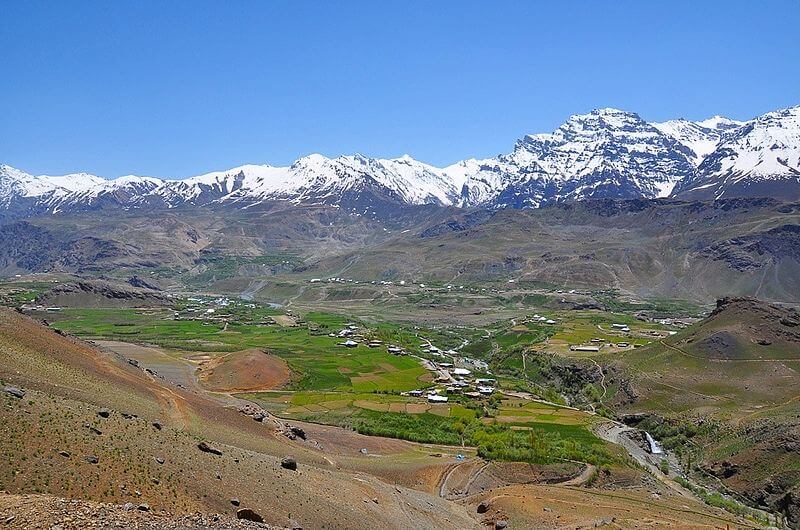The inside story : Mashkoh– Kargil as I saw it # 6

By
Brig Umesh Singh Bawa Vrc, SM
Till early 1999, my unit was stationed in Khrew valley. In mid-April, my unit was deployed for a counter-infiltration role in the Nowgaon sector under the 19 Infantry Division. We were operating in a high altitude area (HAA) at the height of 5000 meters. My troops occupied four posts which were maintained by mules since there was no motorable road connecting my posts.
For the past few years, the melting of the snow has always been heralded by the booming of the guns across the LOC. But this year was expected to be different as just three months earlier, the heads of government of the two countries had embraced each other warmly at the Wagah border, promising to work towards peace. It was expected that the artillery of the two sides would fall silent for a while to give the historic ‘Lahore Declaration’ a chance to succeed. The euphoria, however, melted as rapidly as the snow on the Crestline of Kargil mountains, at the approach of the summer. In the first week of May 99, the Pakistani started pounding the NH 1D and the settlements around Kargil and Dras heavily with their artillery fire. On 09 May, they destroyed the main army ammunition dump outside Kargil town. The ammunition dump was on fire for quite some time before the fire could be doused. A few days later they bombed the Transit Camp at Dras and caused casualties to our troops. It was quite a setback for our force’s morale during that time.

Taken by surprise at the audacity of Pakistan’s action, India’s response was a trifle delayed. It was also a shade too cautious. The gravity of the situation became evident when Defence Minister George Fernandes, visited the area along with the army commander and told the media persons that the intruders would be thrown out within 48 hours. A gross miscalculation!
Reports were now coming from Dras, Mashkoh, Kaksar and Batalik sectors of patrols and helicopters on reconnaissance being fired upon by the intruders. Efforts to remove the intruders were being met with fierce resistance, making it quite clear that this was no ordinary intrusion but a deliberate ingress of occupying the ground. It was apparent that the enemy had established a significant foothold at several points on dominating grounds. Sporadic skirmishes were taking place every day.
At about 2100 hours, 20 May, I got a call from Headquarters 19 Infantry Divisional, informing me that my battalion has been placed on 72 hours’ notice to move to Kargil sector for “Operation Vijay”. My main challenge was to de-induct my companies which were deployed in high altitude mountains in counter infiltration role. I had to get my companies back to battalion base within 48 hours to be ready to move on further instructions. By 22 May evening, the whole battalion had concentrated at the battalion base with their essential loads and was ready to move on further instructions. As I said, being a corps reserve unit, we were used to frequent movements, and my unit was fine-tuned to move at short notice. In the past 18 months, we had moved almost twelve times.
The same evening, I got a message from higher headquarters that 50 vehicles will be placed at battalion base after last light 22 May. I should be ready to move by first light 23 May to my next operational area in the Dras sector, with a night halt on the way at Sonamarg. The vehicles reported at 2200 hours, and we used the whole night loading our vehicles with essential loads, while our cookhouses were busy preparing food for the soldiers, including emergency rations. Emergency rations include sweet shakkar paras and dry matthi to be consumed only when due to some reason regular hot food cannot be served to the soldiers. Early in the morning of 23 May, while my unit boys were ready to get into the vehicles, I thought that I would casually talk to the men about the impending task and check randomly that they were carrying the necessary equipment and stores. During my routine inspection, I asked some of the men to show me the emergency ration they were taking. To my surprise, I found 50% of the men had already consumed their emergency rations. It was in addition to their usual breakfast. When I inquired of them why they did so? They all kept mum, trying to convey that they were ignorant about the orders about not consuming the emergency rations without permission do so. Well, I knew that Jats have a sweet tooth and were fond of sweets, but I never knew that they would consume the emergency rations without orders to eat them. The whole episode made me laugh rather than get annoyed at my men.

I was utterly ignorant about my new location near Dras. I did not have maps of the Dras sector, which was our probable operational area. I was told to collect the requisite maps from Headquarters 19 Infantry Division, which happened to be on the way. We started moving in a convoy of approximately 65 vehicles. We were to move through the insurgent affected area with road opening parties deployed to protect my convoy plus we had our protection party to guard my convoy. I collected the maps from divisional headquarters. We reached Sonamarg at 2000 hours and unpacked ourselves for a night halt. We managed a vacant school building for our night stay so that we do not have to pitch our tents. After eight hours of road journey, we hit our sleeping bags for a well-deserved rest.
24 May forenoon, we reached Matayan, which was supposed to be our concentration area. The moment we got down, I along with my commander (Brig RK Kakkar), went ahead to carry out forward reconnaissance and liaison with the 56 Mountain Brigade (Brig Amar Aul) located at Dras since 22 May. It took us approximately 40 minutes’ drive to reach Dras. My second in command was left behind at Matayan to establish a camp for the battalion.
Dras is India’s coldest inhabited place with temperatures dipping to around minus 40 degrees in winters. Summer is when the residents rediscover their smiles. They indulge in the great delight of taking a stroll. Children play in the open. Farmers are on tractors in the fields. In April, schools open after four-month-old winter break. The day time temperature in Dras is 2-3 degrees. Snow still covers the high mountains that ring this small town in Kashmir. But this summer was different, all the villages wore a deserted look, the children were missing, the schools were closed, and there were no farmers to cultivate their lands. The enemy had been targeting the villages and inhabited areas with artillery fire at regular intervals, hence the population had moved behind to safer places, leaving behind their belongings including their livestock and pet animals. However, some elders were left behind to look after the left-over assets in the village. We could see the high mountain peaks of Tololing, Tiger Hill and Point 4875 from Dras.
During the initial briefing, the brigade commander of Dras brigade briefed us on the latest situation in the area. He also acquainted us with the critical heights of Tololing, Tiger HiIl and Point 4875. During his briefing on Point 4875, he told us dryly that there were not more than eight to ten infiltrators on the heights overlooking Mashkoh valley, “Just go up”, he ordered with casual bravado, “And bring them down by their neck”. We were also shown Point 4875 and Point 4540 on the ground, overlooking the Mashkoh valley. Till now no patrols had been sent in Mashkoh valley and the heights around it by any unit. It was a virgin area not exploited by any of our patrols. After our initial briefing at Dras, I and my commander drove down towards Mashkoh valley to carry out a quick visual reconnaissance of the area and select our next assembly area (AA).
As we drove down, we saw the main ridgeline containing Point 4875 and Point 4540. Point 4875 dominated the entire Mashkoh bowl. Anyone sitting on top of this feature could easily view and dominate the stretch of 30 km on the National Highway 1D from Matayan to Dras. We were told that Pakistani intruders who were occupying Point 4875 were directing heavy artillery fire on our army convoys which were moving in this stretch since May 1999. Due to enemy firing, most of the convoys used to move after the last light. Besides this, Point 4875 was like a virtual fortress, and anyone who was defending it could quickly push back the attackers and inflict heavy casualties on them. The feature was not just a single peak; it consisted of a series of dominating heights. Hence capture of Point 4875 was considered essential in the scheme of things. The slopes were almost 70 to 80 degrees, and the height of the feature was 16200 feet. The rocks were barren without any cover. The ridges were virgin with no foot tracks leading to them. There was not enough oxygen to breathe.
To the east was Tiger Hill and Tolling, where another mountain brigade was planning their operations. After the initial visual reconnaissance, I returned to Matayan. Just after last light, as we were settling down in our tents, we were welcomed by the enemy artillery shelling near our camp area. We were taken by surprise, and in a few seconds, I found everybody outside their tents and taking position next to the nearest boulder or stone they could find. We realised that the intruders were well armed with artillery and mortars. It was not a counter-insurgency operation. We were in the war zone! Probably, our camp area was under enemy observation, and they were waiting for us to establish our camp before they could dislodge us from there. After that, all the tents were removed, and we all spent the rest of the night in an open area, well tucked into the hill feature to escape the enemy shelling. Since larger tents were more visible from a distance, we bid for additional smaller puff tents for the unit. It was our first experience of enemy artillery shelling so close to us.-
As I sat barely, 10 km south of the border with Pakistan, my thoughts raced back to Jul 78, when I joined my battalion as a Second Lieutenant. At that time, I believed the chances of leading my battalion into battle were virtually nil. How wrong I was! It seemed that fate had intervened and I was to get my chance to command in war after all. I could not believe my luck, and I could barely contain my excitement when I told my wife Indu, on the telephone, that operations were imminent. I could feel the uneasy calm in her voice when I told her that I am in the battle zone. They heard on the television about the Pakistani infiltrators in the Kargil sector and the regular exchange of fire between the troops and the infiltrators. I also had an uneasy feeling that being a soldier was in direct conflict with my duties as a husband and father. There was no doubt that I wanted to go to war, but I also felt slightly guilty that I might be reneging on my parental duty to stay alive and bring up my children. As I became more and more embroiled in the planning process, the dilemma faded from my thoughts. There was, after all, nothing I could do about it except ensure that my family would be financially secure in the event of my death.
A letter received from the father of one of my radio operators just after we arrived in the battle zone, helped me to put the issue into perspective. In the letter to his son, the father wrote “if ever you were to face the enemy bullets, face them on your chest and not your back. If the bullet is received on your chest, it would mean that you fought like a tiger and if it is received on your back, the whole village will say that he got the bullets while running away from the enemy fire”. In the same letter, he also wished me well as the commanding officer and asked me to bring his son back safely from the war zone. The reality of responsibility towards the lives of 800 troops under me and get them back safely from the battlefield had never been so clear.



